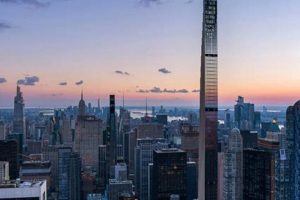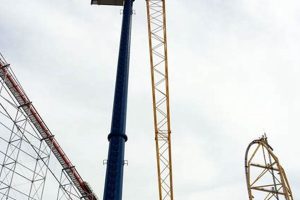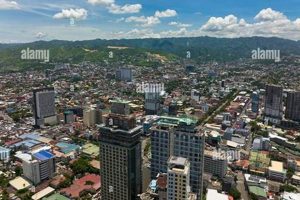Skyscrapers, towering structures that dominate the urban landscape, have become a defining characteristic of Shanghai, China’s most populous city. These architectural marvels not only provide breathtaking views and coveted office space but also serve as symbols of economic prosperity and technological advancement.
The rapid growth of skyscrapers in Shanghai began in the early 2000s, fueled by the city’s booming economy and its ambitious plans for modernization. Today, Shanghai boasts over 100 buildings that rise above 150 meters, with many more under construction. Among the most iconic skyscrapers in Shanghai are the Shanghai Tower, the second-tallest building in the world, and the Jin Mao Tower, known for its distinctive shape and traditional Chinese architectural elements.
The construction of skyscrapers in Shanghai has been driven by several factors. Firstly, the city’s limited land area has necessitated building upwards to accommodate its growing population and businesses. Secondly, skyscrapers have become a symbol of prestige and economic power, with many companies and individuals seeking to occupy prime real estate in these coveted structures. Thirdly, the development of advanced construction techniques and materials has made it possible to build taller and more innovative skyscrapers than ever before.
1. Height
The height of skyscrapers in Shanghai is a defining characteristic that sets them apart from other cities. Over 100 buildings in Shanghai rise above 150 meters, including the second-tallest building in the world, the Shanghai Tower. This remarkable height has several implications:
- Vertical Expansion: Skyscrapers allow Shanghai to expand vertically, optimizing land use in a densely populated city. By building upwards, Shanghai can accommodate more people and businesses within a limited geographical area.
- Economic Power: Tall skyscrapers have become symbols of economic power and prestige. The presence of numerous skyscrapers in Shanghai reflects the city’s thriving economy and its status as a major global financial center.
- Engineering Marvels: The construction of skyscrapers requires advanced engineering techniques and materials to ensure their stability and safety. The height of these buildings pushes the boundaries of architectural innovation.
- Urban Landmarks: Skyscrapers have become iconic landmarks that define Shanghai’s skyline. They are instantly recognizable symbols of the city’s modern and cosmopolitan character.
In conclusion, the height of skyscrapers in Shanghai is not merely a physical attribute but also a reflection of the city’s economic growth, engineering prowess, and architectural ambition. These towering structures have transformed Shanghai’s skyline and contributed to its reputation as a global metropolis.
2. Architecture
The architectural diversity of skyscrapers in Shanghai is a testament to the city’s rich cultural heritage and its embrace of modern innovation. Traditional Chinese elements, such as curved roofs and intricate ornamentation, can be found in skyscrapers like the Shanghai World Financial Center. In contrast, modern and futuristic designs, such as the twisting form of the Shanghai Tower, reflect the city’s forward-looking spirit. This blend of architectural styles creates a visually captivating urban landscape.
The diverse architecture of skyscrapers in Shanghai is not merely aesthetic; it also serves several practical purposes. Traditional Chinese architectural elements, such as the use of courtyards and open spaces, help to create a sense of community and well-being within these towering structures. Modern and futuristic designs, on the other hand, often incorporate sustainable features, such as energy-efficient facades and rainwater collection systems, contributing to the city’s environmental goals.
Understanding the connection between architecture and skyscrapers in Shanghai is essential for appreciating the city’s unique character. The diverse architectural styles reflect Shanghai’s rich history and its status as a global metropolis. By incorporating traditional Chinese elements into modern skyscrapers, Shanghai architects have created a harmonious blend of heritage and innovation that sets the city apart.
3. Construction
Advanced construction techniques and materials have been pivotal in the development of skyscrapers in Shanghai. These innovations have enabled the construction of taller and more innovative buildings, pushing the boundaries of architectural design and engineering.
One key factor has been the use of high-strength concrete and steel, which allow for the construction of structures that are both strong and lightweight. This has been essential for the construction of supertall skyscrapers, such as the Shanghai Tower, which stands at 632 meters tall.
Another important innovation has been the development of new facade systems. These systems are designed to withstand the high winds and other environmental forces that skyscrapers are subjected to. They also play a key role in the energy efficiency of buildings, helping to reduce heat loss and gain.
The use of advanced construction techniques and materials has not only enabled the construction of taller skyscrapers but has also allowed for more innovative designs. For example, the Shanghai Tower features a unique twisting shape that reduces wind loads and provides panoramic views of the city.
The construction of skyscrapers in Shanghai is a testament to the ingenuity and innovation of the city’s architects and engineers. By embracing advanced construction techniques and materials, they have created some of the most iconic and awe-inspiring buildings in the world.
4. Economics
In the context of skyscrapers in Shanghai, the economic significance of these structures cannot be overstated. Skyscrapers have become symbols of economic power and prestige, with many companies and individuals seeking to occupy prime real estate in these coveted structures. This phenomenon is driven by several key factors:
- Vertical Concentration of Businesses: Skyscrapers allow businesses to concentrate their operations in a single, convenient location, fostering collaboration and efficiency. This vertical concentration is particularly valuable in densely populated cities like Shanghai, where land is scarce.
- Enhanced Corporate Image: Occupying space in a prestigious s
kyscraper can significantly enhance a company’s image and reputation. Skyscrapers are often associated with success, innovation, and financial stability, which can attract top talent and clients. - Investment Opportunities: Skyscrapers offer attractive investment opportunities for individuals and institutions seeking high returns. The value of skyscraper real estate tends to appreciate over time, making it a lucrative investment for many.
- Economic Growth Indicator: The construction and occupancy of skyscrapers are often seen as indicators of economic growth and prosperity. Skyscrapers represent a significant investment in a city’s infrastructure and contribute to its overall economic development.
The economic significance of skyscrapers in Shanghai is undeniable. These structures not only provide functional office space but also serve as symbols of economic power, prestige, and growth. By understanding the economic factors that drive the demand for skyscraper real estate, we gain a deeper appreciation for the role these structures play in shaping the urban landscape and contributing to the city’s economic success.
5. Engineering
The engineering behind skyscrapers in Shanghai is a marvel of modern architecture and engineering. Innovative structural designs and wind-resistant technologies are essential to ensuring the stability of these towering structures, which face unique challenges due to their height and exposure to strong winds.
- Structural Innovation: Skyscrapers in Shanghai employ innovative structural systems, such as diagrid structures and supercolumns, which distribute weight and forces more efficiently. These systems allow for taller and more slender buildings while maintaining structural integrity.
- Wind-Resistant Technologies: Shanghai’s skyscrapers are equipped with advanced wind-resistant technologies, such as tuned mass dampers and aerodynamic shaping. Tuned mass dampers counteract wind-induced vibrations, while aerodynamic shaping reduces wind resistance and turbulence.
- Foundation Engineering: The foundations of skyscrapers in Shanghai are crucial for their stability. Deep pile foundations and advanced soil improvement techniques are used to anchor these structures firmly in the soft soil conditions often found in Shanghai.
- Seismic Design: Shanghai is located in a seismically active region, so skyscrapers are designed to withstand earthquakes. Shear walls, moment-resisting frames, and base isolation systems are incorporated into the structural design to mitigate seismic forces.
The engineering behind skyscrapers in Shanghai showcases the ingenuity and expertise of architects and engineers. By pushing the boundaries of structural design and employing innovative technologies, they have created some of the tallest and most iconic buildings in the world, which continue to shape the city’s skyline and contribute to its reputation as a global architectural hub.
6. Function
Skyscrapers in Shanghai are not merely architectural marvels; they also serve a multitude of functions that contribute to the city’s vibrant urban life. These functions range from providing office space for businesses to offering residential units, hotels, and retail options, making skyscrapers essential components of Shanghai’s urban fabric.
- Office Space: Skyscrapers in Shanghai house a significant portion of the city’s office space, accommodating businesses of all sizes and industries. The vertical concentration of office space in skyscrapers promotes efficiency, collaboration, and access to amenities within a single location.
- Residential Units: Many skyscrapers in Shanghai offer luxury residential units, providing stunning views of the city skyline and access to high-end amenities. These units cater to a growing demand for upscale urban living, offering a unique blend of convenience and exclusivity.
- Hotels: Skyscrapers in Shanghai often incorporate hotels into their design, providing visitors with unparalleled views and convenient access to the city’s attractions. These hotels offer a range of accommodation options, from budget-friendly to luxurious suites, catering to both business travelers and tourists.
- Retail: The lower levels of skyscrapers in Shanghai frequently house retail spaces, offering a wide range of shopping options. These retail spaces benefit from high foot traffic and visibility, making them attractive to both local and international brands.
The diverse functions of skyscrapers in Shanghai reflect the city’s dynamic and multifaceted character. By combining office space, residential units, hotels, and retail within a single structure, skyscrapers maximize land use, foster community, and contribute to the overall livability of the city. Understanding the functional aspects of skyscrapers in Shanghai provides a deeper appreciation for their role in shaping the urban environment and meeting the needs of its inhabitants.
7. Land use
In densely populated cities like Shanghai, land is a precious commodity. The construction of skyscrapers has been a strategic solution to optimize land use and accommodate the city’s growing population and businesses.
Skyscrapers allow for vertical expansion, maximizing the use of available land. By building upwards, Shanghai has been able to create more space for residential, commercial, and public use without encroaching on valuable green spaces or displacing existing neighborhoods.
For example, the Shanghai Tower, one of the tallest buildings in the world, houses offices, retail spaces, a hotel, and even a museum within a single structure. This vertical integration reduces the need for sprawling horizontal developments, preserving land for other essential purposes.
Optimizing land use through skyscrapers has several practical benefits. It promotes efficient urban planning, reduces traffic congestion by centralizing activities, and creates a more vibrant and livable city center.
In conclusion, the construction of skyscrapers in Shanghai is not merely about creating architectural landmarks but also about addressing the challenges of land scarcity in a densely populated urban environment. By optimizing land use, skyscrapers play a vital role in shaping Shanghai’s urban landscape and contributing to its sustainable growth.
8. Sustainability
In the context of skyscrapers in Shanghai, sustainability has become an increasingly important consideration. Many skyscrapers in the city are now designed and constructed with sustainability features that reduce their environmental impact and promote resource conservation.
- Green Building Materials:
Skyscrapers in Shanghai are increasingly utilizing sustainable building materials, such as recycled steel and low-VOC (volatile organic compound) paints, to minimize their environmental
impact during construction and throughout their lifespan. - Energy Efficiency:
To reduce energy consumption, skyscrapers in Shanghai often incorporate energy-efficient lighting systems, such as LED lighting, and motion sensors to minimize energy waste. Advanced building management systems optimize energy usage and reduce overall operating costs. - Water Conservation:
Water conservation is a key aspect of sustainability in skyscrapers. Rainwater collection systems capture and store rainwater for non-potable uses, such as irrigation and toilet flushing, reducing the strain on municipal water supplies. - Indoor Environmental Quality:
Skyscrapers in Shanghai prioritize indoor environmental quality by incorporating natural ventilation systems and air filtration technologies to ensure a comfortable and healthy indoor environment for occupants.
The integration of sustainability features in skyscrapers in Shanghai not only reduces their environmental impact but also contributes to the overall sustainability of the city. By promoting energy efficiency, water conservation, and indoor environmental quality, these skyscrapers are helping to create a more sustainable and livable urban environment.
FAQs on Skyscrapers in Shanghai
This section addresses frequently asked questions related to skyscrapers in Shanghai, providing informative and concise answers to common concerns and misconceptions.
Question 1: What is the tallest skyscraper in Shanghai?
Answer: The Shanghai Tower, standing at a height of 632 meters (2,073 feet), is the tallest skyscraper in Shanghai and the second-tallest building in the world.
Question 2: How many skyscrapers are there in Shanghai?
Answer: Shanghai boasts over 100 skyscrapers that rise above 150 meters (492 feet), making it one of the cities with the highest concentration of skyscrapers globally.
Question 3: What are the unique architectural features of Shanghai’s skyscrapers?
Answer: Skyscrapers in Shanghai showcase a diverse range of architectural styles, from traditional Chinese elements to modern and futuristic designs. This architectural diversity reflects Shanghai’s rich cultural heritage and its embrace of innovation.
Question 4: What are the main functions of skyscrapers in Shanghai?
Answer: Skyscrapers in Shanghai serve a variety of functions, including providing office space, residential units, hotels, and retail options. These functions contribute to the city’s vibrant urban life and cater to the needs of its diverse population.
Question 5: How do skyscrapers in Shanghai address sustainability concerns?
Answer: Many skyscrapers in Shanghai incorporate sustainability features such as energy-efficient lighting, rainwater collection systems, and green building materials. These features reduce the environmental impact of these buildings and promote resource conservation.
Question 6: What is the significance of skyscrapers in Shanghai’s urban development?
Answer: Skyscrapers in Shanghai have played a pivotal role in optimizing land use, accommodating the city’s growing population and businesses, and shaping its iconic skyline. These structures contribute to Shanghai’s reputation as a global architectural hub and a symbol of economic prosperity.
These FAQs provide a deeper understanding of skyscrapers in Shanghai, highlighting their architectural significance, functional diversity, and contributions to the city’s urban fabric and sustainable development.
Transition to the next article section:
To further explore the fascinating world of skyscrapers in Shanghai, let’s delve into their historical evolution and the innovative engineering techniques employed in their construction.
Tips for Experiencing Skyscrapers in Shanghai
To make the most of your visit to Shanghai’s skyscrapers, consider the following tips:
Tip 1: Plan Your Visit
Before your visit, research different skyscrapers and identify those that align with your interests. Consider factors such as height, architectural style, and available amenities.
Tip 2: Book Tickets in Advance
To avoid long queues and secure your spot, especially during peak season, book your tickets for observation decks or tours online in advance.
Tip 3: Arrive Early
Arrive at the skyscraper early to avoid crowds and maximize your time at the observation deck. This will allow you to enjoy the views without feeling rushed.
Tip 4: Choose a Clear Day
For the best views, plan your visit on a clear day with minimal haze or smog. This will ensure optimal visibility and stunning panoramic vistas.
Tip 5: Take Your Time
Once at the observation deck, take your time to soak in the breathtaking views. Allow yourself ample time to explore different angles and capture memorable photos.
Tip 6: Utilize Available Amenities
Many skyscrapers offer additional amenities such as restaurants, cafes, or interactive exhibits. Take advantage of these amenities to enhance your experience and learn more about the skyscraper’s design and history.
Skyscrapers in Shanghai
This exploration of skyscrapers in Shanghai has unveiled their multifaceted significance, extending beyond their architectural grandeur. These towering structures embody the city’s economic prowess, engineering ingenuity, and commitment to sustainable urban development.
As Shanghai continues to evolve, its skyline will undoubtedly be further transformed by innovative and sustainable skyscraper designs. These architectural marvels will continue to serve as testaments to human ambition and the pursuit of progress. Whether admired from afar or experienced firsthand, the skyscrapers of Shanghai inspire awe and wonder, leaving a lasting impression on all who encounter them.







